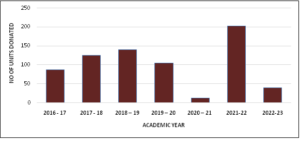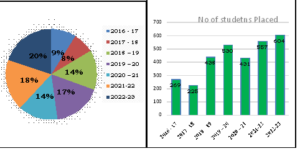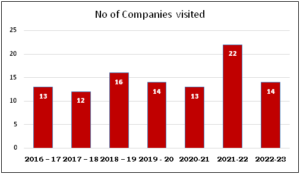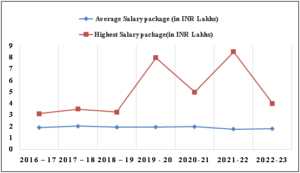College Code : 048
Vijayam Science and Arts Degree College was established in 2003.Since then,
t he college committed in good practice.
The institution motivates the young minds to value voluntary services and vitalize them to donate blood for the needy and save their lives. The institution encourages them for serving the needy people like orphans and people at old age homes.
The dire necessity of emergency cases is blood which is very difficult to get some times. With this concern the college has setup a team for blood donation.
The institution stated a concept of ‘one rupee collection’ to help the orphanages and old-age homes. The institution helps to the needy after assessing various parameters.
Thinking to maintain clean India joining Swach Barath Mission, greenery is maintained in public places. Conducted awareness programme on Organic forming. Medical camps were set up in rural areas.
Most of the rural areas lack of safe drinking water which leads to various disease. Institution aimed to provide safe drinking water in the rural areas a water plant has been set up to provide safe RO Drinking water.
Blood Donation:
To save the lives, the institution consistently in collaboration with the Indian Red Cross Society is organizing Blood Donation Camps. So far19Blood donation camps has been conducted and approximately 3040 units of blood have been donated to the blood banks. The head of the institution is also a member of the Indian RedCross Society. Every year many students donate blood to save people’s life
The volunteers visit orphanage and old age homes every month to providenecessary commodities and medical help. The institution also helps the student families in case of any mishaps
As a part of social responsibility, the institution funded for greenery initiation, seating arrangements in public places like bus stand and Government hospital. conducted awareness programme for farmers to adopt Organic farming. Medical camps were conducted in the rural areas.
The institution setup RO water plant in Puthalapattu to ensure safe drinking water in rural areas, which servers more the 20000 liters of purified water per day.
Through these activities the students are channelized for communal harmony and social service.
On an average every year, students donate 115 units of blood. And also donate during emergency cases. Institution received “Seva Samithi award”from Biswabhusan Harichandan (the hon’ble governor of AP) for the activities during the year 2018 – 2019. In the previous year too, the institute received “Seva(service) award” from E.S.L Narasimhan (The hon’ble governor of AP). Many honorary awards have been awarded for this noble practice to the institution.
The students have donated 711 units of blood over the past six years and the summary for the past six academic years( 2016-2023) is shown in Table1.
|
AcademicYear |
2016 -17 |
2017 -18 |
2018 – 19 |
2019 – 20 |
2020 – 21 |
2021-22 |
2022-23 |
|
Number ofunitsdonated |
87 |
125 |
140 |
105 |
12 |
203 |
39 |
The year wise blood donation metrics shown in Figure1.

Around 20 villages are benefited by mineral water plant irrespective of their locality. This plan thas been serving more than 20,000 liters of purified drinking water per day. Medical camp has been conducted in the rural areas to provide medical help. And also conducted awareness programme for farmers on organic farming.
The institution came across lot of misconceptions among students retarding blood donation. Sometimes parents did not accept for donating blood.
Few doubts were expressed regarding collecting the funds that it might be misused. The institution contributed whenever the funds were insufficient for the needy. Few farmers hesitated to follow organic farming methods. Later they were convinced with this programme.
Finally, the institution believes that helping to needy is an act of humanity.
Campus Recruitment Training (CRT) and Placement Activities
One of the salient features of the institute is CRT program. Sensing the future needs of corporate sector and skills that are in demand, the institution established a separate cell to improve the skill development among the students.The training experts monitor the students in all three-year tenure of the graduation.In the final year nearly 6 months training isgiving to students in the areas like Aptitude, Reasoning, Technical skills, and Communication skills.
It is the cherished dream of the institution to share the fruits of knowledge and play a vital role in molding young minds towards designed destinations. Aptly designed and properly implemented programs are blessing the institution with immaculate and imminent triumphs.The purposeful journey of the institution with an averted distinction is highly hopeful to make miraculous and thumping success in the educational spectrum. The unified target is being ventured with an association of stalwarts, who are the makers of remarkable achievements.The distinctive and majestic programs of the institution are designed to facilitate the confluence of knowledge, attitudea nd executions skills into.
The rigorous training program is meticulously planned and implemented by senior faculty members who possess meritorious record in their respective knowledge areas. CRT is an intense placement-oriented drill. The training is conducted to train students for upcoming drives.Intensive training on technical and core knowledge of all streams are provided. Aptitude training programs are conducted to assess and enhance the candidate’s problem-solving capability. Analytical and Logical reasoning tests are conducted regularly to improve their ability. Conducting Group Discussion among the students on contemporary topics and guide them where they wentwrong.
Exclusive training on communication, attitude, confidence, enthusiasm,behavior skills are provided to boost up the confidence. Mock interviews / Resume writing practices are conducted to enlighten their performance. Career guidance programme was conducted in the college with the help of guest lecturer
The program is initiated with high expectation and vision to provide placements for the rural background students in and around 50km radius of Chittoor. The ardent and sincere steps that the institution has taken started yielding very good results.
It is honor to bring the following details of the total placements achieved by the college so far since 2016-2017 to 2022-2023. The data over the years show that thes tudents of the college stood exemplary and they became role models for their junior wards.
The summary of student placement data for the past six academic years is shown in Table 1.
|
Academic Year |
2016–2017 |
2017-2018 |
2018–2019 |
2019-2020 |
2020- 2021 |
2021-2022 |
2022-2023 |
|
Number ofoutgoingstudents |
683 |
730 |
790 |
838 |
983 |
948 |
908 |
|
Number ofstudents placed |
269 |
225 |
438 |
530 |
431 |
557 |
604 |
|
Percentageof placements |
39.38 |
30.82 |
55.44 |
63.25 |
43.84 |
58.75 |
66.5 |
Table 1. Summary of placement details for the past five academic years
The graphical representation of year wise placement percentage and number of students placed is as shown in Figure1.

Fig.1.Placement percentage and number of students placed during 2016-2023
The summary of number of companies visited, average and highest packages for the past seven academic years (2016-2023) are presented in Table 2.
|
Academic Year |
2016–17 |
2017–18 |
2018–19 |
2019-20 |
2020-21 |
2021-22 |
2022-23 |
|
Number ofcompaniesvisited |
13 |
12 |
16 |
14 |
13 |
22 |
14 |
|
Averagesalary package (inINRLakhs) |
1.91 |
2.02 |
1.93 |
1.95 |
1.98 |
1.77 |
1.8 |
|
HighestSalarypackage(in INRLacks) |
3.10 |
3.50 |
3.25 |
8.00 |
5.00 |
8.5 |
4.0 |
Table 2. Summary of number of companies visited and average packages for the past Seven academic years

The number of companies visited for the past seven academic years year wise is presented in Figure2.
Fig.2. The number of companies visited during last seven academic years

The average and highest salary package of the students for the past seven academic years (2016-2023)is presented in Figure3.
Fig.3.The average salary package of the students for the past seven academic years
Most of the students of the college are from rural background, and they are fromTelugu medium. Lack of Communication skills is one of the major hurdles forcampusinterview.Therefore, studentsfaced issues with the communication in their interviews. Therefore, special attention is needed to improve their skills like communication,Personality development etc.Periodically CRT classes are conducted beyond the college class hours. However, a few students could not attend the classes due to logistic issues.
Another major challenge faced was many MNCs hesitate to come to our campus as the institute is located in semi-urban area.
It becomes a challenging task for our students to balance both academics and placement training activities due more academic workload.
Getting a right CRT trainer on campus has been a challenging task. Moreover,providingstudentswithboth aptitudeandverbal skills,andcompany specifictechnicaltrainingwasatestfortheinstituteto placethestudents.